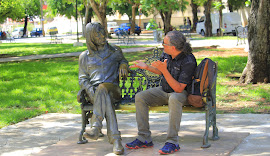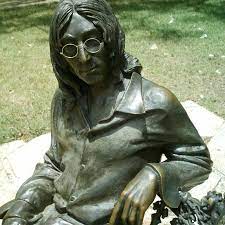
JOHN LENNON Y SU PROFANADA ESTATUA EN UN PARQUE HABANERO, LA SEGUNDA ERIGIDA EN AMERICA LATINA.
El Parque John Lennon, establecido en la primera mitad del siglo xx, anteriormente conocido como Parque Menocal, es un parque público ubicado en el Vedado de La Habana, Cuba.
El nombre anterior era Parque Menocal, en honor al tercer presidente de la República de Cuba Mario García Menocal.
En uno de los bancos del parque, cerca de la esquina de las calles 17 y 6, se encuentra una escultura del exmiembro de los Beatles, John Lennon, obra del artista cubano José Villa Soberón, sentado en el extremo derecho.
En una baldosa de mármol al pie del banco hay una inscripción que dice: “Dirás que soy un soñador pero no soy el único” John Lennon, que es una traducción al español de la letra en inglés “You may say I’m a dreamer, but I’m not the only one” (Puedes decir que soy un soñador, pero no soy el único), de la canción “Imagine”.
Fue a partir de la colocación en el de una estatua de tamaño natural del famoso compositor inglés e integrante del legendario cuarteto Los Beatles y la segunda y única erigida en América Latina sentado en un banco.
El lugar tiene forma rectangular, con una plaza circular en el centro rodeada por un muro que se fracciona en cuatro de sus extremos permitiendo el acceso a través de escaleras de 9 peldaños. Posee grandes arboledas, plantas ornamentales y césped. Un hermoso parque con grandes pasillos y bancos de hierro, donde el fresco y el verdor hacen de él un lugar muy agradable.
A principios de la década de los noventa, el primer concierto para Lennon se comenzó a gestar y fue una iniciativa de Carlos Alfonso, Ele y Síntesis, a la cual se sumaron también los músicos Carlos Varela, Santiago Feliù, Pepe Piñeiro (ex-integrante de Los Pacíficos), Dagoberto Pedraja, el grupo Gens, Pablo Menéndez y su grupo Mezcla, Gerardo Alfonso, otros músicos y, por supuesto, un grupo de amigos cineastas, escritores, pintores, técnicos y locos por la vida que teníamos el amasado sueño de homenajear a Lennon y Los Beatles.
Hacer justicia por la ofensa y la ingratitud que había significado en los años 60 y 70 la prohibición oficial en Cuba de los Cuatro de Liverpool. El concierto tendría lugar en la azotea baja del Hotel Habana Libre, en la esquina de L y 23, corazón de La Rampa y una de las zonas más transitadas de la capital. El plan era montar todo el sonido y el aparataje de grabación de vídeo un viernes y que coincidiera con las actividades del Festival Internacional del Nuevo Cine Latinoamericano, pero sin hacer la más mínima publicidad ni anuncio alguno, de similar forma que John, Paul, George y Ringo lo habían hecho en Inglaterra en el último concierto al final de sus años como banda y que fue nombrado popularmente como “concierto en la terraza” o “concierto en el tejado de los estudios Apple”.
Sin embargo, esto no fue aprobado por las autoridades de gobierno, pero en eso apareció la posibilidad de hacerlo en el parque de 17. Los vecinos de esa zona habían dado su respaldo y decidieron colaborar con el evento.
La escultura de Lennon actualmente no lleva sus características gafas redondas, que han sido robadas o vandalizadas en varias ocasiones. Sin embargo, durante el día, un guardia de seguridad se sienta junto al banco y coloca las gafas en la estatua si se le solicita.
UN ACTO DE DESAGRAVIO
En diciembre de 1990 se efectuó en este parque un multitudinario concierto al que asistieron miles de habaneros, para rendirle el homenaje que hacia años se le venía debiendo. En este concierto participaron importantes músicos cubanos, como Carlos Alfonso con el grupo Síntesis, Carlos Varela, Santiago Feliú, Pablo Menéndez con el grupo Mezcla, Dagoberto Pedraja, Pablo Menéndez, Esteban Puebla, Pepe Piñeiro, entre otros.
La mayoría de los reunidos ahí pertenecían a los denominados “Hijos de Guillermo Tell”. Carlos Varela, acompañado del Grupo de rock Gens, aportó aun más a la emoción general, tocando su pieza “Guillermo Tell”, que era casi un himno para todos. Aquella muchedumbre vibró como nunca. Una vez terminada la emblemática pieza, Varela tomó el micrófono y propuso bautizar a ese parque con el nombre de John Lennon, y así se llamó a partir de ese día. De pronto vino “Hey Jude” y con un coro gigante se cerró así el inolvidable concierto.
Existen pocos registros audiovisuales de ese día, según Jorge Dalton creador del programa de televisión “A Capella” se logró registrar en vídeo parte de lo que aconteció allí e hicieron un programa especial con la conductora Lily Rentería. Algunas imágenes del concierto en blanco y negro se conservan.
La estatua se inauguró el 8 de diciembre de 2000, coincidiendo con el 20.º aniversario del asesinato de Lennon.
Un año después, el autor cubano Ernesto Juan Castellanos escribió un libro sobre la estatua, “John Lennon en La Habana con un poco de ayuda de mis amigos”, y sobre la prohibición que John Lennon y los Beatles sufrieron en Cuba durante las décadas de 1960 y 1970.

JOHN LENNON, AND HIS DESECRATED STATUE IN A HAVANA PARK, THE SECOND ERECTED IN LATIN AMERICA.
John Lennon Park, established in the first half of the 20th century, formerly known as Menocal Park, is a public park located in the Vedado district of Havana, Cuba.
Its previous name was Menocal Park, in honor of the third president of the Republic of Cuba, Mario García Menocal.
On one of the park benches, near the corner of 17th and 6th Streets, sits a sculpture of former Beatles member John Lennon, the work of Cuban artist José Villa Soberón, seated on the far right.
On a marble tile at the foot of the bench is an inscription that reads: “You may say I’m a dreamer, but I’m not the only one.” John Lennon, which is a Spanish translation of the English lyrics “You may say I’m a dreamer, but I’m not the only one” from the song “Imagine.”
It was founded after the installation of a life-size statue of the famous English composer and member of the legendary Beatles quartet, the second and only one erected in Latin America, sitting on a bench.
The site is rectangular in shape, with a circular plaza in the center surrounded by a wall divided into four corners, allowing access via nine-step staircases. It features large groves of trees, ornamental plants, and lawns. A beautiful park with large walkways and iron benches, where the cool air and greenery make it a very pleasant place.
In the early 1990s, the first Lennon concert began to take shape. It was an initiative of Carlos Alfonso, Ele, and Síntesis, which was also joined by musicians Carlos Varela, Santiago Feliù, Pepe Piñeiro (former member of Los Pacíficos), Dagoberto Pedraja, the group Gens, Pablo Menéndez and his group Mezcla, Gerardo Alfonso, other musicians, and, of course, a group of filmmakers, writers, painters, technicians, and life-lovers who had the cherished dream of paying tribute to Lennon and The Beatles.
To do justice to the offense and ingratitude that the official ban of the Liverpool Four in Cuba in the 1960s and 1970s had meant. The concert was to take place on the lower rooftop of the Hotel Habana Libre, at the corner of L and 23rd Streets, the heart of La Rampa and one of the busiest areas of the capital. The plan was to set up all the sound and video recording equipment on a Friday, coinciding with the International Festival of New Latin American Cinema, but without any publicity or announcements, similar to how John, Paul, George, and Ringo had performed in England for their final concert at the end of their years as a band, which was popularly known as the “terrace concert” or “concert on the roof of Apple Studios.”
However, this was not approved by government authorities, but the possibility of holding it in 17th Street Park arose. The residents of that area had given their support and decided to collaborate with the event.
The Lennon sculpture currently does not wear its characteristic round glasses, which have been stolen or vandalized on several occasions. However, during the day, a security guard sits next to the bench and places the glasses on the statue upon request.
AN ACT OF REVOLVEMENT
In December 1990, a massive concert attended by thousands of Havana residents was held in this park to pay tribute to him, a tribute that had been owed for years. Important Cuban musicians participated in this concert, such as Carlos Alfonso with the group Síntesis, Carlos Varela, Santiago Feliú, Pablo Menéndez with the group Mezcla, Dagoberto Pedraja, Pablo Menéndez, Esteban Puebla, Pepe Piñeiro, among others.
Most of those gathered there belonged to the so-called “Sons of William Tell.” Carlos Varela, accompanied by the rock group Gens, further contributed to the general excitement, playing his piece “Guillermo Tell,” which was practically an anthem for everyone. The crowd vibrated like never before. Once the iconic piece was finished, Varela took the microphone and proposed naming the park after John Lennon, and that’s what it was called from that day on. Suddenly, “Hey Jude” came out, and a giant choir brought the unforgettable concert to a close.
Few audiovisual records exist of that day. According to Jorge Dalton, creator of the television program “A Capella,” part of what happened there was captured on video, and a special program was made with host Lily Rentería. Some black-and-white images of the concert are preserved.
The statue was inaugurated on December 8, 2000, coinciding with the 20th anniversary of Lennon’s assassination.
A year later, Cuban author Ernesto Juan Castellanos wrote a book about the statue, “John Lennon in Havana with a Little Help from My Friends,” and about the prohibition that John Lennon and the Beatles suffered in Cuba during the 1960s and 1970s.

Agencies/ Wiki/ JohnLennonPark/ Nostalgia Cubana/ Carlos Rodriguez Bua/ Extractos/ Excerpts/ Internet Photos/ Arnoldo Varona.
www.TheCubanHistory.com
THE CUBAN HISTORY, HOLLYWOOD.




 JOHN LENNON Y SU PROFANADA ESTATUA EN UN PARQUE HABANERO, LA SEGUNDA ERIGIDA EN AMERICA LATINA. PHOTOS. * JOHN LENNON, AND HIS DESECRATED STATUE IN A HAVANA PARK, THE SECOND ERECTED IN LATIN AMERICA. PHOTOS.
JOHN LENNON Y SU PROFANADA ESTATUA EN UN PARQUE HABANERO, LA SEGUNDA ERIGIDA EN AMERICA LATINA. PHOTOS. * JOHN LENNON, AND HIS DESECRATED STATUE IN A HAVANA PARK, THE SECOND ERECTED IN LATIN AMERICA. PHOTOS.